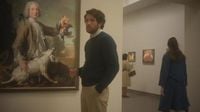It’s not every day that a film about a botched art heist manages to capture the mood of an entire era, but Kelly Reichardt’s latest, The Mastermind, does just that—with a quiet, simmering energy that’s unmistakably her own. Premiering at the 2025 Edmonton International Film Festival (EIFF) and opening at the Film Center on October 24, Reichardt’s film has quickly become a talking point among cinephiles and critics alike. With a cast led by Josh O’Connor, Alana Haim, Hope Davis, and John Magaro, the movie is set in Massachusetts in 1970, a period marked by political upheaval, draft dodgers, and a sense of dislocation that seeps into every frame.
According to MovieJawn, the story centers on James Mooney (O’Connor)—or, as some reviewers note, James Blaine ‘JB’ Mooney—an unemployed carpenter and former art student who never quite lived up to his privileged beginnings. He’s the son of a stern Judge (Bill Camp) and Sarah (Hope Davis), who quietly supports him financially behind his father’s back. James is married to Terri (Alana Haim), a woman whose simmering frustration is palpable, and together they have twin boys, played by Sterling and Jasper Thompson. The family dynamic is fraught, with James borrowing money under false pretenses to fund his ill-conceived plan: stealing four Arthur Dove paintings from the local museum, a nod to his own failed artistic ambitions.
The heist itself, as described by Newcity Film, is anything but slick. James enlists a group of equally unskilled accomplices, and the plan begins to unravel almost immediately—one small but telling detail is his careless touch on a getaway car window, leaving behind a fingerprint. The fallout is swift. As things go awry, James bolts, leaving Terri and the kids with his parents and hitting the road in a desperate bid to outrun the consequences of his actions.
Reichardt’s approach to the material is anything but conventional. While the premise suggests a fast-paced crime caper, The Mastermind is, in fact, a slow burn—a film that “cogitates,” as Newcity Film puts it, lingering on the small moments and textures that define its world. The 1970s setting is more than just a backdrop; it’s a living, breathing character in its own right. The film is suffused with the faded, autumnal colors reminiscent of photographers like Stephen Shore and William Eggleston, evoking a sense of nostalgia that’s both comforting and unsettling. As Ray Pride notes, "the look of 'The Mastermind' is sublime, evoking the faded, autumnal colors of photographers of that era like Stephen Shore, and the deadpan but telling framing of a Fred Herzog or William Eggleston."
Music and sound design play a pivotal role as well. Rob Mazurek’s score is vibrant and tactile, drawing comparisons to the expressive paranoia of 1970s classics like The Parallax View and The Conversation. The world of The Mastermind is alive with the sounds of footsteps, train horns, and distant cop cars, all woven together to heighten the film’s sense of unease and dislocation. The sound design, as Newcity Film highlights, is "exceptional: pulled back a little from naturalism, woven with well-chosen sounds to heighten; crisp footsteps or train horns or cop cars preceded their appearance. A world passes JB by, but the moment is ever-present."
But it’s the performances that truly anchor the film. Josh O’Connor, known for his ability to inhabit characters who are both sympathetic and deeply flawed, delivers a quietly devastating turn as James. Every line on his face, every hesitant gesture, speaks volumes about the character’s internal turmoil. Alana Haim and Gaby Hoffmann, though given relatively little dialogue, convey a “practiced fury” with just their expressions—refusing to indulge James’s self-pity or rationalizations. As Newcity Film observes, "Reichardt’s female characters haven’t much to say, but the faces of Haim and Hoffmann contain a practiced fury: They do not countenance this foolish failure once the deed has been pronounced."
Throughout, Reichardt trusts her audience. She doesn’t spoon-feed motivations or moral judgments. Instead, she lets the story unfold in its own time, inviting viewers to look deeper, to sit with the discomfort and ambiguity. The film’s pacing is deliberate, almost meditative, rewarding those willing to engage with its subtleties. As MovieJawn puts it, "Her filmmaking is slow, methodical. It’s full of texture and layers for those with the patience and willingness to look for it."
Political and social context is never far from the surface. The 1970s setting brings with it echoes of the Vietnam War—news footage flickers in the background, a Black soldier tells his story in a bar, and protest marches thread through the narrative. These elements ground James’s story in a broader landscape of unrest and uncertainty, suggesting that his attempt to “disappear” is as much about escaping the world as it is about personal failure. According to Newcity Film, "The events of the 1970s are glancingly evoked: a Black soldier in a bar tells a story; belts of bullets fed through a helicopter’s gunnery from news footage from Vietnam chatter in the background; Walter Cronkite is glimpsed in a building across the way through curtains and overlapping window frames."
As James flees, he reconnects with college friends Fred (John Magaro) and Maude (Gaby Hoffmann), who seem to understand—perhaps better than he does—why he’s chosen this path. Their interactions are brief but loaded with history and unspoken judgment, underscoring the film’s themes of empathy and consequence. James’s journey is less about redemption than about reckoning with the choices that brought him here.
The film’s conclusion is, in the words of Newcity Film, “almost madcap; thrilling, absurd, correct.” Without giving too much away, Reichardt leaves viewers with a sense of ambiguity—a question mark hanging over whether it’s truly possible to leave one’s life behind, to dematerialize into the wallpaper of history. The final scenes evoke the existential uncertainty of Michelangelo Antonioni’s The Passenger, with a 360-degree pan that takes in the stasis of a man caught between expiration and explosion.
The Mastermind isn’t for everyone. Its slow pace and refusal to offer easy answers may frustrate some viewers, but for those willing to engage with its rhythms, it offers a rich, rewarding experience. It’s a film that lingers, much like the faded colors of its 1970s landscapes, asking viewers to reflect on the ways we run from ourselves—and whether, in the end, any of us can truly get away.




